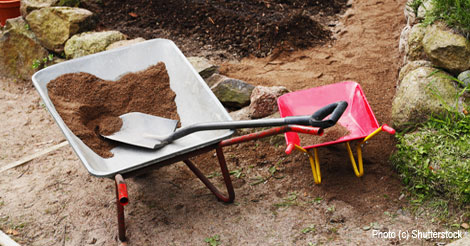|

Seven Tips to Help Gardeners Weed Out the Soreness
As you begin to get outside into your garden this year, you will want to check out your tools. And the most important gardening tool is the human body. Thirty minutes of planting or yard work provides great health benefits, such as preserving flexibility, increasing mobility and building strength and endurance. However, gardeners – especially those who are out of shape or don’t move properly – can strain muscles in the lower back, shoulders, knees and arms. So one of the best ways to begin planning your garden is to get in shape! The Canadian Physiotherapy Association (CPA) notes that because they are crouching, bending, reaching, and lifting, gardeners need to prepare their bodies. Whether you’re a master gardener or budding amateur, the CPA suggests these safety tips:
1. Begin with a warm up – Start slowly, or go for a five-minute walk to warm up your muscles. Then stretch all major muscle groups, especially back, neck and fingers.
2. Pace Yourself – Don’t try to do everything at once. Take breaks throughout your work and do some gentle stretching to keep limber. Vary tasks to make sure different muscles get used and one particular muscle group is not overworked.
3: Raking or hoeing – Keep your tools close to your body and your back straight to reduce strain. Use your arms and avoid twisting your trunk. Use long-handled tools suited to your height. If you find you need to bend over or reach too far while raking, consider using an ergonomic rake to make the job easier and reduce strain to your back.
4. Weeding or planting – Do not bend from the waist. Squat or kneel on a kneeling pad. Give your back, legs and knees a break from stooping and kneeling by using tools with long handles to help with the weeding. Squat or sit on the ground to trowel, rather than bending over.
5. Digging or shoveling – Insert the head of the shovel vertically into the ground and step on the blade. Lift small amounts at a time and bend at the knees, using your legs not your back to lift the load. Avoid twisting. Use a wheelbarrow to move big or heavy loads. Choose a shovel with a weight and handle length that is appropriate for your size and for the job you are doing. Give your back a break by using a smaller shovel, reducing the temptation to lift large amounts of soil. Pace yourself.
6. Lifting or carrying – Know your limits and lift properly. Bend your knees, not your back, keeping the load close to your body. Don’t lift items that are too heavy for you. Use a wagon or wheelbarrow to transport supplies and to move heavy items. A four-wheeled cart is sturdier and easier to use than a wheelbarrow. Lift with your knees slightly bent and your back straight. Avoid twisting or reaching.
7. Pruning or trimming – Get as close to your work as possible. Don’t stretch beyond your reach or past your stable footing. Rehearse the movement as a stretch first to test your ability and positioning. Match the size of the tool handle to the size of your hand; choose tools that you can hold so that your hand remains positioned in line with your forearm, in a loose grip. Adapt them for ease and comfort by padding the handles and wrapping them with tape to improve your grip.
|

